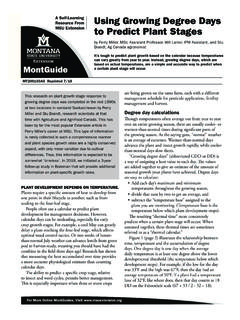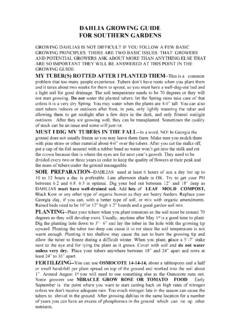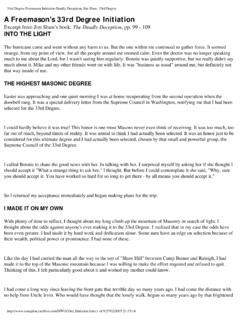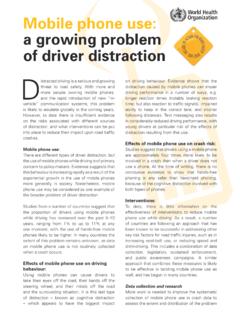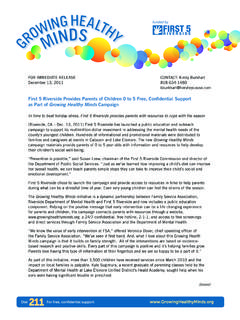Transcription of A 360-DEGREE PEER EVALUATION OF LEADERSHIP …
1 A 360-DEGREE peer EVALUATION OF LEADERSHIP COMPETENCIESByAnthony Rogers, MBADISSERTATIONP resented to the Faculty of the Departmentof Center for LEADERSHIP StudiesOur Lady of the Lake University,in Partial Fulfillment of the RequirementsFor the degree ofDoctor of Philosophyin LEADERSHIP StudiesOur Lady of the Lake UniversitySan Antonio, TexasJuly 31, 20012 AbstractThis study examined a model of LEADERSHIP in the fire service and evaluated the selectionprocess of two of the seven LEADERSHIP roles in the San Antonio Fire Department fireapparatus operator (FAO) and lieutenant. The selection process is based primarily on theresults of a written examination that ranks firefighters on their raw test scores and numberof years of experience, which is referred to as seniority points. Although there arenumerous studies on LEADERSHIP theories and behavior patterns, the amount of literatureavailable on the LEADERSHIP selection process especially in the fire service is severelylimited.
2 The purposes of this study were to: (1) determine whether the leadershipselection process in the San Antonio Fire Department is identifying firefighters withleadership competencies as identified by the Booth Research Group (1998) and theRogers Firefighters Survey (2001) conducted on firefighters to determine leadershipcompetencies relevant to the fire service, and (2) suggest relevant criteria for selectingfirefighters for LEADERSHIP roles in the fire service. A 360-DEGREE peer EVALUATION thatcontains 57 questions that are used as the criterion variable was used to rate theleadership performance of FAOs and lieutenants. Data collected were correlated todetermine whether the LEADERSHIP selection process is related to selecting firefighters withleadership competencies . To determine the degree of relationship, four variables acriterion and three predictors that include scores on the written promotional examination,years of service, years of formal education, and scores on the 360-DEGREE peerevaluation were wish first to thank God for the strength, courage, and wisdom with which Heequipped me to complete my dissertation and the lengthy journey toward a doctor sdegree.
3 I pray that the Lord will enable me to use the knowledge and wisdom I haveattained to better serve and honor Him. I also wish to thank my children, Catherine andAmanda, who sacrificed their quality time with me so that I could complete my studies. Iwant to thank my fellow firefighters who place their lives on the line 24 hours a have supported me and cheered me on during the journey to complete my , I extend my gratitude to my chair, Dr. Malcolm J. Ree, and the committeemembers for their support and encouragement. I want to thank Sally for her continuoussupport. Above all, I want to thank my devoted wife, Patsy Mae, without whose constantencouragement and support I never could have completed the program. I am OF CONTENTSABSTRACT .. iiACKNOWLEDGEMENTS ..iiiTABLE OF ivINTRODUCTIONR esearch 6 Problem 7 Purpose of This REVIEWT heoretical Literature on LEADERSHIP .. 12 Definitions of LEADERSHIP .. 12 Models and Theories of LEADERSHIP .
4 13 LEADERSHIP Selection Process in the Fire Service .. 18 Collective Bargaining Contract Agreement .. 22 Promotional Examination Process ..23 LEADERSHIP Prediction of Verification and Measurement ofLeadership In the Fire 385 METHODOLGYR esearch Design .. 41 Criterion and Predictor Variables .. 41 Null Hypotheses ..42 The Participants .. 42 The Instrument .. 43 Data Collection .. 45 Data Analysis .. 46 Ethical Decisions .. 46 RESULTSD escriptive Statistics of Participants .. 47 Hypotheses .. 61 Discussion .. 62 Recommendations .. 67 REFERENCES .. 69 APPENDIXESA ppendix A FAO Practical Skills .. 76 Appendix B Lieutenant Performance Dimensions .. 77 Appendix C Rogers Firefighters Survey ..78 Appendix D Five competencies Identifiedby the Booth Research Group .. 796 Appendix E-Six Firefighters LEADERSHIP competencies Identifiedby the Rogers Survey .. 80 Appendix F 360-DEGREE peer EVALUATION .. 81 Appendix G-Hunter and Schmidt PredictiveValidity Table.
5 85 Appendix H-Letter Granting PermissionTo Conduct Study .. 86 Appendix I-Consent Form .. 877 CHAPTER ONEINTRODUCTIONIn today s dangerous world, 9-1-1 fire and medical emergencies occur every fiveseconds. Fire kills thousands of people each year, injures hundreds of thousands ofothers, destroys billions of dollars in property, and costs tens of billions of dollars(USFA, 1999). Firefighters help protect the public against these dangers by quicklyresponding to a variety of emergencies. Frequently they are the first emergency personnelat the scene of an accident or medical emergency and may be called upon to put out afire, treat injuries, rescue trapped victims, or perform other vital functions (Bureau ofLabor Statistics, 2000).The fire service is facing a growing spectrum of job responsibilities and the needfor effective LEADERSHIP is even greater than in the past. If the need for effective leadershipin the fire service is growing, what might be done to select firefighters with effectiveleadership competencies ?
6 What are the LEADERSHIP competencies relevant to the fireservice? What selection process would accurately measure or validate the need forleadership competencies ? Part of the answer is to look at the selection and promotionprocess and compare it with the LEADERSHIP competencies needed in the fire service, asidentified by the Booth Research Group (1998) and the Rogers Firefighters Survey(2001).Applicants for municipal fire-fighting jobs generally must pass a written exam;tests of strength, physical stamina, coordination, and agility; and a medical examinations generally are open to individuals who are at least 19 years ofage and have a high school education or the equivalent. Those who receive the highest8scores in all phases of testing have the best chance of receiving an appointment to the firedepartment (Miller, 1997).As a rule, entry-level cadets in large fire departments are trained for several weeksat the department s training center or academy.
7 The recruits study fire-fightingtechniques, fire prevention, hazardous-materials control, local building codes, andemergency medical procedures that include first aid and cardiopulmonary resuscitation(CPR). They also learn how to use axes, chain saws, fire extinguishers, ladders, and otherfire-fighting equipment and rescue equipment. After successfully completing this courseof study, they are assigned to a fire company where they undergo a one-year probationaryperiod of on-the-job training (Bureau of Labor Statistics, 2000).During this time the probationary firefighter is assigned to a fire station where heor she will work directly under the supervision of the company officer and the othersenior firefighters assigned to the company. Throughout this period, the probationaryfirefighter is exposed to all the elements of the fire service, thereby gaining valuableexperience. Upon completion of the probationary period, the probationary firefighter isupgraded to the classification of firefighter (IAFF Local 624, 1999).
8 According to the International City Management Association (1979), leadershipin the fire service is a critical role because life-saving decisions often are dependent onthe leader s ability to act decisively and make sound decisions on the fire ground as wellas in administrative situations. Traditionally, firefighters were selected for leadershiproles based on job seniority as well as their ability to fight fire by frequently withstandinga smoky inferno without the protection of a breathing apparatus; hence, the term smokeeater was coined. Currently, opportunities for promotion to LEADERSHIP in the fire service9are based on seniority and the results of a multiple-choice, written examination. The stepsto LEADERSHIP begin with promotion to fire apparatus operator (FAO), and move up thehierarchy to lieutenant, captain, battalion chief, assistant chief, deputy chief, and finally,fire and police municipal civil service laws regulate the classification andappointment of firefighters to LEADERSHIP roles.
9 Chapter 143 of the Texas LocalGovernment Codes provides specific guidelines regarding the entrance examination aswell as the written promotional examination process for municipal fire service (Miller,1997). In addition, collective bargaining agreements between firefighters unions andmunicipal governments also regulate the LEADERSHIP promotion process in the fire bargaining agreements often describe the eligibility criteria, seniority points,study material, written examination, assessment-center process, assessment-centerpromotion dispute resolution procedures, probationary period, appointments to assistantchief and deputy chief, and the mechanics of posting promotional examination results(IAFF Local 624, 1999).According to the Texas Local Government Codes (Miller, 1987), the leadershipselection process in the fire service in Texas begins with a vacancy. When a vacancyoccurs, a written multiple-choice promotion examination is administered.
10 On November1 of each year, the San Antonio Fire Department s fire chief establishes a committee(s) toselect study material for examinees to use in preparing for the written promotionexamination. The fire chief makes the final selection of the study material, subject toapproval by the Civil Service Commission (IAFF Local 624, 1999). Exam questions areformulated from the study material, which is based on a job analysis designed to assess10the knowledge, skills, abilities, and other characteristics (KSAOs) needed for effectiveperformance in the San Antonio Fire Department (Booth Research Group, 1998). Thenames of examinees whose scores meet the minimum score required for promotionconsideration are placed on an eligibility Booth Research Group (2000) is a consulting firm that develops writtenpromotional examinations for hundreds of positions in various organizations, includingthe fire service. Their written examinations are customized to reflect the organizationalneeds of their clients.
